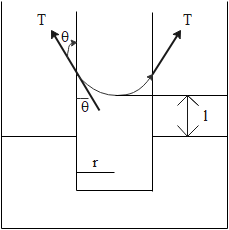
The rise of a liquid in a capillary tube depends on:
A. The material
B. The length
C. The outer radius
D. The inner radius of the tube
Answer
502.8k+ views
1 likes
Hint: The force of surface tension is balanced by weight of liquid. We can make use of this relation to calculate the formula for rise of a liquid in a capillary tube. The contact angle of liquid is the angle it makes with the walls of the container. It depends both on liquid as well as container.
Complete step by step solution:
When a capillary is dipped in a liquid, the force of surface tension lifts the liquid upward. As there is no other force to balance it, the liquid starts rising. As it happens the weight of the raised liquid starts countering force due to surface tension. After a specific length the force due to surface tension is balanced by weight of liquid. So, the liquid stops rising. Hence, we can say that the weight of liquid must be equal to force due to surface tension.
Let us consider a capillary, the liquid has raised its final length l, T is surface tension of liquid, r is radius of capillary,
The liquid forms a cylinder of radius r and height l. Weight of the liquid can be written as product of density and volume
Force due to surface tension can be written as a product of surface tension and the length where it’s acting. The length where its acting is equal to
But this force is acting along the contact angle and only a component of it will balance the weight. And that component will be

So we can say that
On solving for l, we get
So the rise of a liquid in a capillary tube depends on surface tension of liquid, contact angle, density of liquid and inner radius of capillary.
Contact angle depends on material of capillary tube.
So the correct options are A and C.
Note: The weight of the liquid taken here is not exactly accurate. We have not taken into account the weight of liquid present above height l. It could be taken into account if we know the value of
Complete step by step solution:
When a capillary is dipped in a liquid, the force of surface tension lifts the liquid upward. As there is no other force to balance it, the liquid starts rising. As it happens the weight of the raised liquid starts countering force due to surface tension. After a specific length the force due to surface tension is balanced by weight of liquid. So, the liquid stops rising. Hence, we can say that the weight of liquid must be equal to force due to surface tension.
Let us consider a capillary, the liquid has raised its final length l, T is surface tension of liquid, r is radius of capillary,
The liquid forms a cylinder of radius r and height l. Weight of the liquid can be written as product of density and volume
Force due to surface tension can be written as a product of surface tension and the length where it’s acting. The length where its acting is equal to
But this force is acting along the contact angle and only a component of it will balance the weight. And that component will be

So we can say that
On solving for l, we get
So the rise of a liquid in a capillary tube depends on surface tension of liquid, contact angle, density of liquid and inner radius of capillary.
Contact angle depends on material of capillary tube.
So the correct options are A and C.
Note: The weight of the liquid taken here is not exactly accurate. We have not taken into account the weight of liquid present above height l. It could be taken into account if we know the value of
Latest Vedantu courses for you
Grade 10 | CBSE | SCHOOL | English
Vedantu 10 CBSE Pro Course - (2025-26)
School Full course for CBSE students
₹35,000 per year
Recently Updated Pages
Master Class 12 Business Studies: Engaging Questions & Answers for Success

Master Class 12 English: Engaging Questions & Answers for Success

Master Class 12 Social Science: Engaging Questions & Answers for Success

Master Class 12 Chemistry: Engaging Questions & Answers for Success

Class 12 Question and Answer - Your Ultimate Solutions Guide

Master Class 12 Economics: Engaging Questions & Answers for Success

Trending doubts
Give 10 examples of unisexual and bisexual flowers

Draw a labelled sketch of the human eye class 12 physics CBSE

Differentiate between homogeneous and heterogeneous class 12 chemistry CBSE

Write a short note on Franklands reaction class 12 chemistry CBSE

Differentiate between insitu conservation and exsitu class 12 biology CBSE

What are the major means of transport Explain each class 12 social science CBSE




